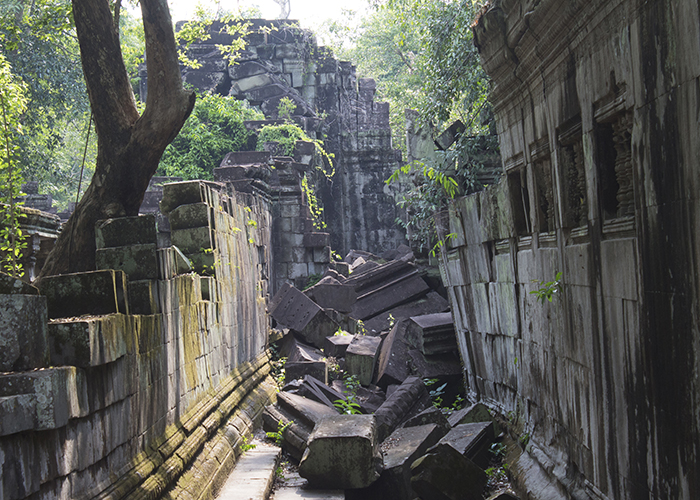 Previous Day |
Siem Reap, CM → Phnom Kulen NP → Siem Reap, CM 121.2 mi (195.0 km) |
 Next Day |
This morning, we were up early once again to enjoy a delicious buffet in the Golden Temple’s dining area and to meet Nara and Dora from Taxi in Cambodia! Nara runs the company, and we’d arranged for a tour of some of the more distant, less crowded parts of Siem Reap Province. Maybe there, I figured, we’d be in luck for finding durians.
So, with Dora behind the wheel and Nara as our guide, Mu Sab and I set off on another day of hot, humid, jungle adventure! We headed north from Siem Reap along the narrow, unnamed road, stopping briefly to watch a woman churn palm juice into sugar. It was the same way, Nara explained, that the Hindu gods and demons churned the legendary Sea of Milk to reach the divine treasures hidden deep below! We would see traces of this story all along the way today, starting at the mysterious, tiny temple of Banteay Srei!
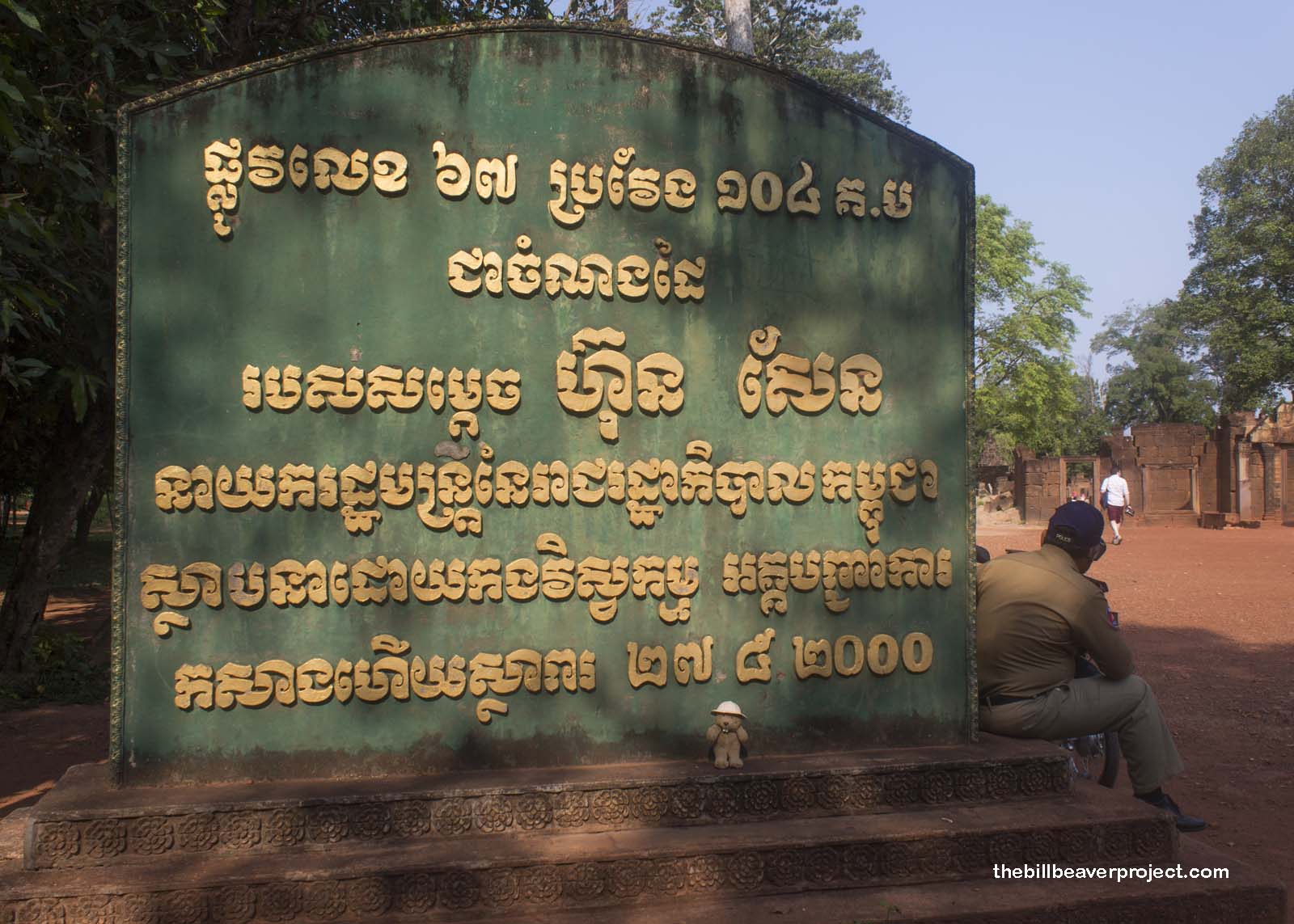 |
Banteay Srei is unique among the many temples of the Angkor Complex. It is tiny—maybe 15 feet tall—and it is pink! As Nara explained, while the rest of the Angkor temples were built with gray sandstone quarried from nearby Phnom Kulen, Banteay Srei was built out of an entirely different, entirely pink variety. The closest pink sandstone quarry, he revealed, was all the way in India!
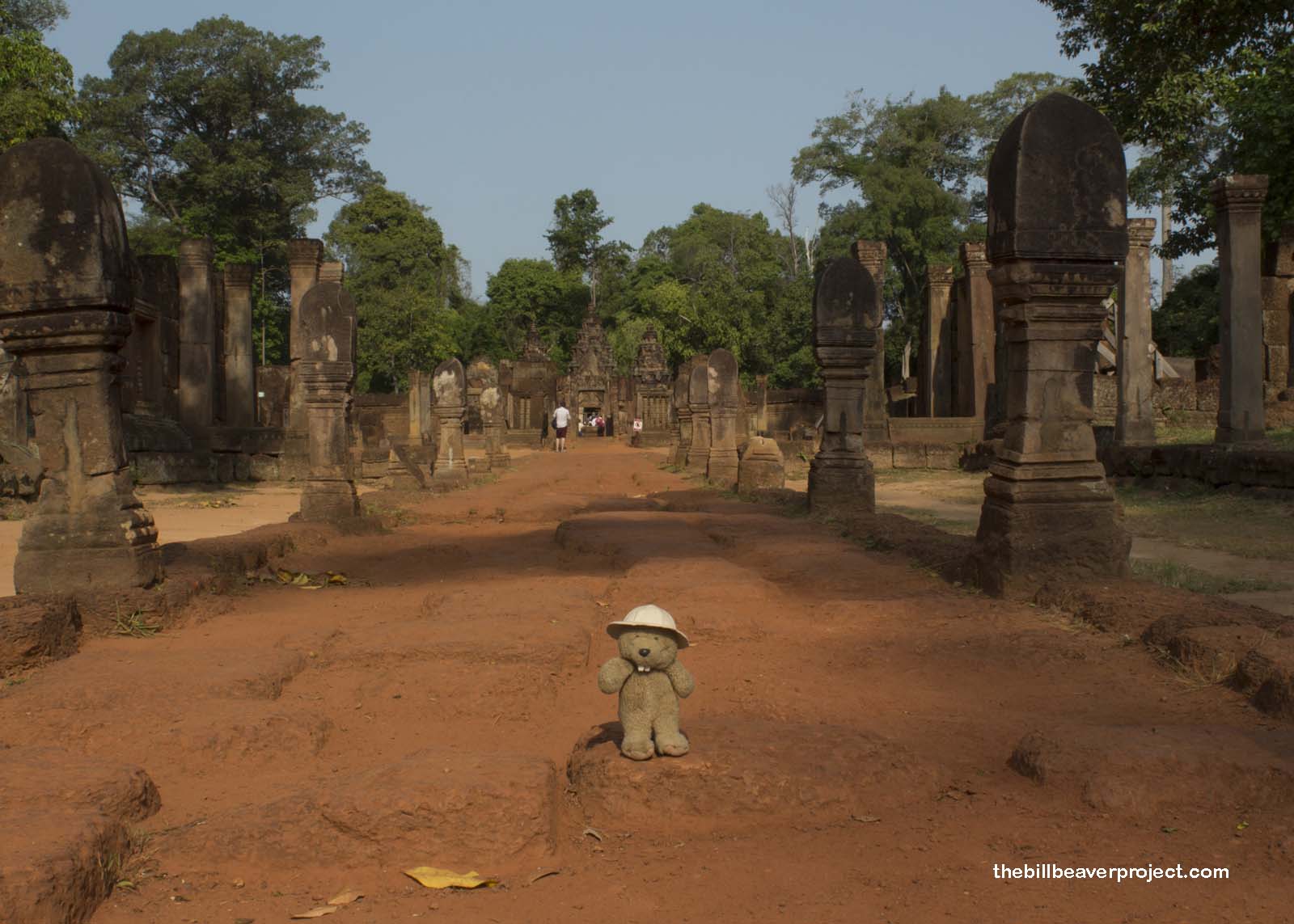 |
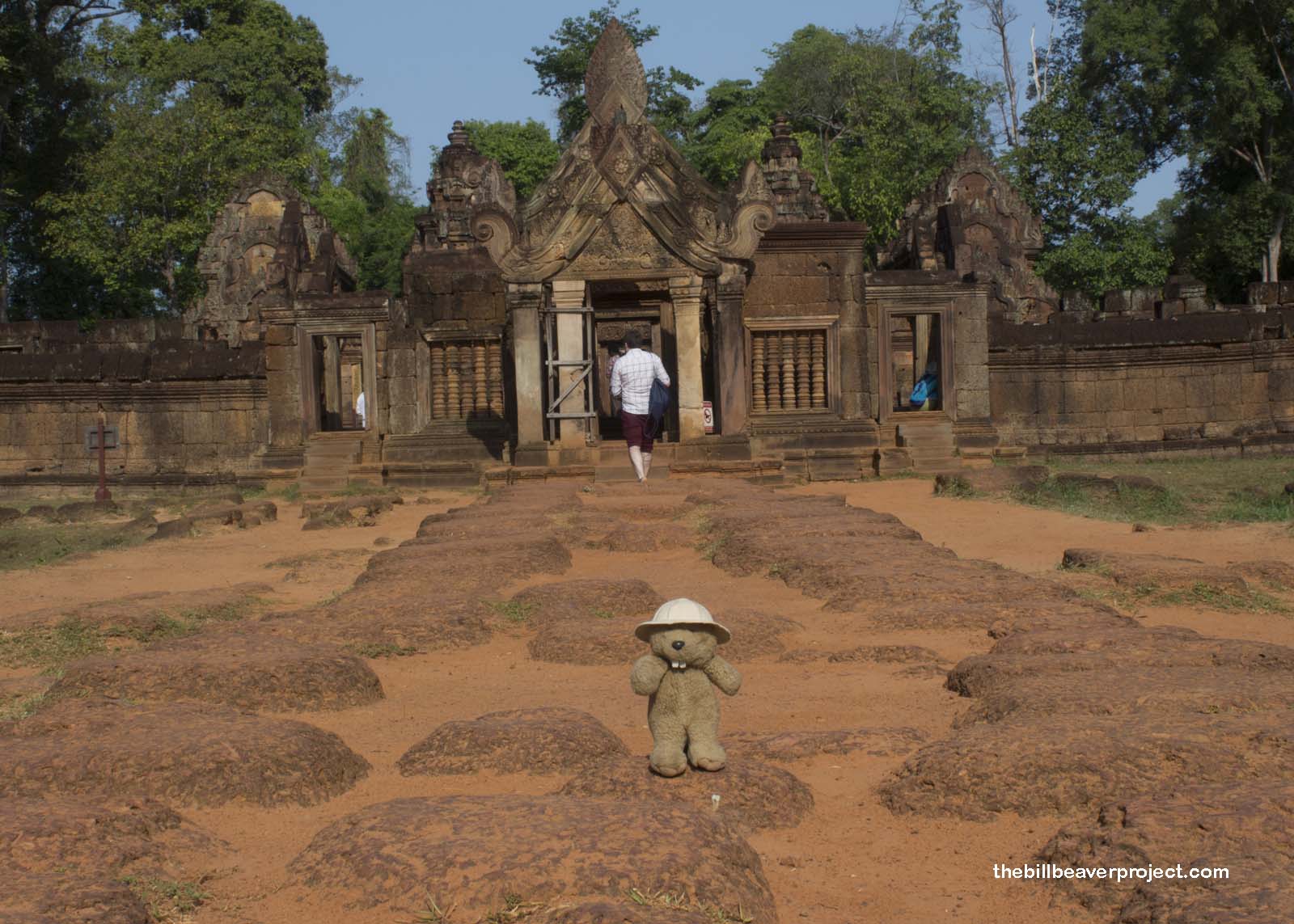 |
But India’s influence on Cambodia was obvious from the start. Banteay Srei is a Hindu temple dedicated to the god, Shiva. Variously called “the pink temple” or the “citadel of women,” because its intricate carvings “could only have been made by women,” it was originally called Tribhuvanamahesvara after Shiva, the “great lord of the threefold world!”
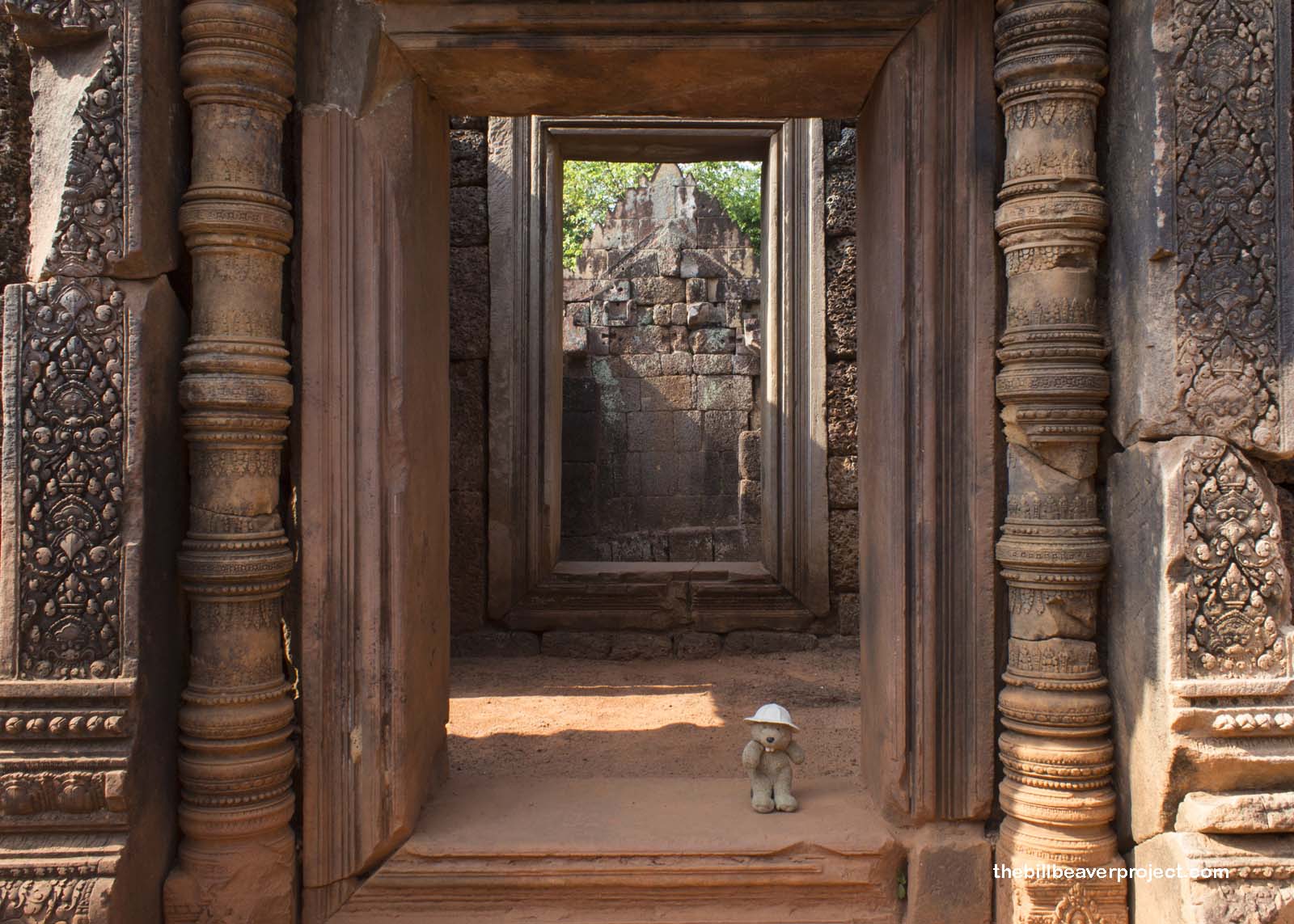 |
Banteay Srei has been exquisitely preserved, from its finely scaled Naga carvings to its unspoiled Garuda statues, to the very specific date of its founding: April 22, 967! It was the only one of the Angkor temples that wasn’t built by a king (which explains the size) but the priest and royal physician of King Rajendravarman, named Yajnyavahara! A musician, astronomer, and practitioner of ayurvedic medicine, Yajnyavahara’s attention to beauty has left us modern explorers with something truly dazzling to behold!
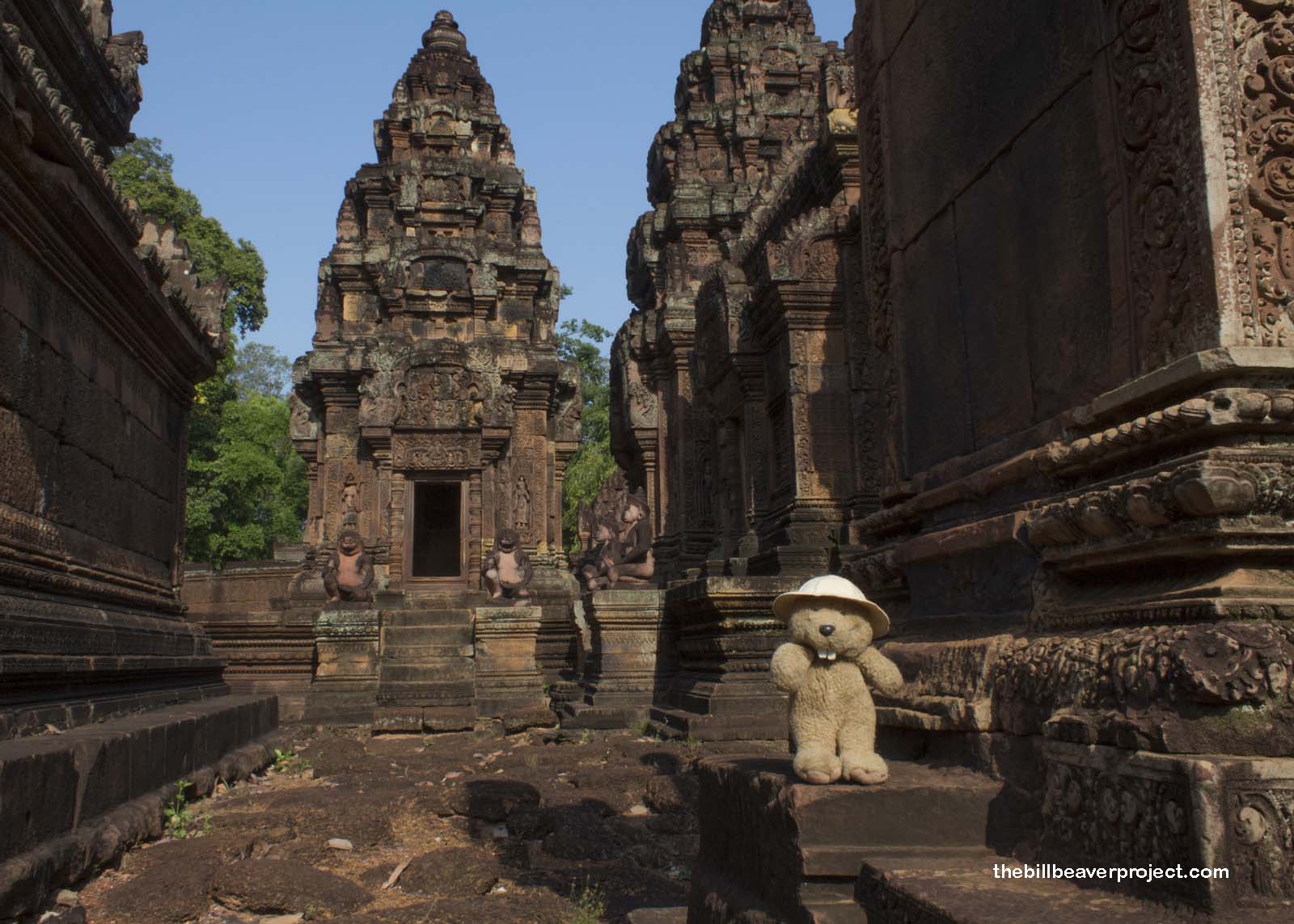 |
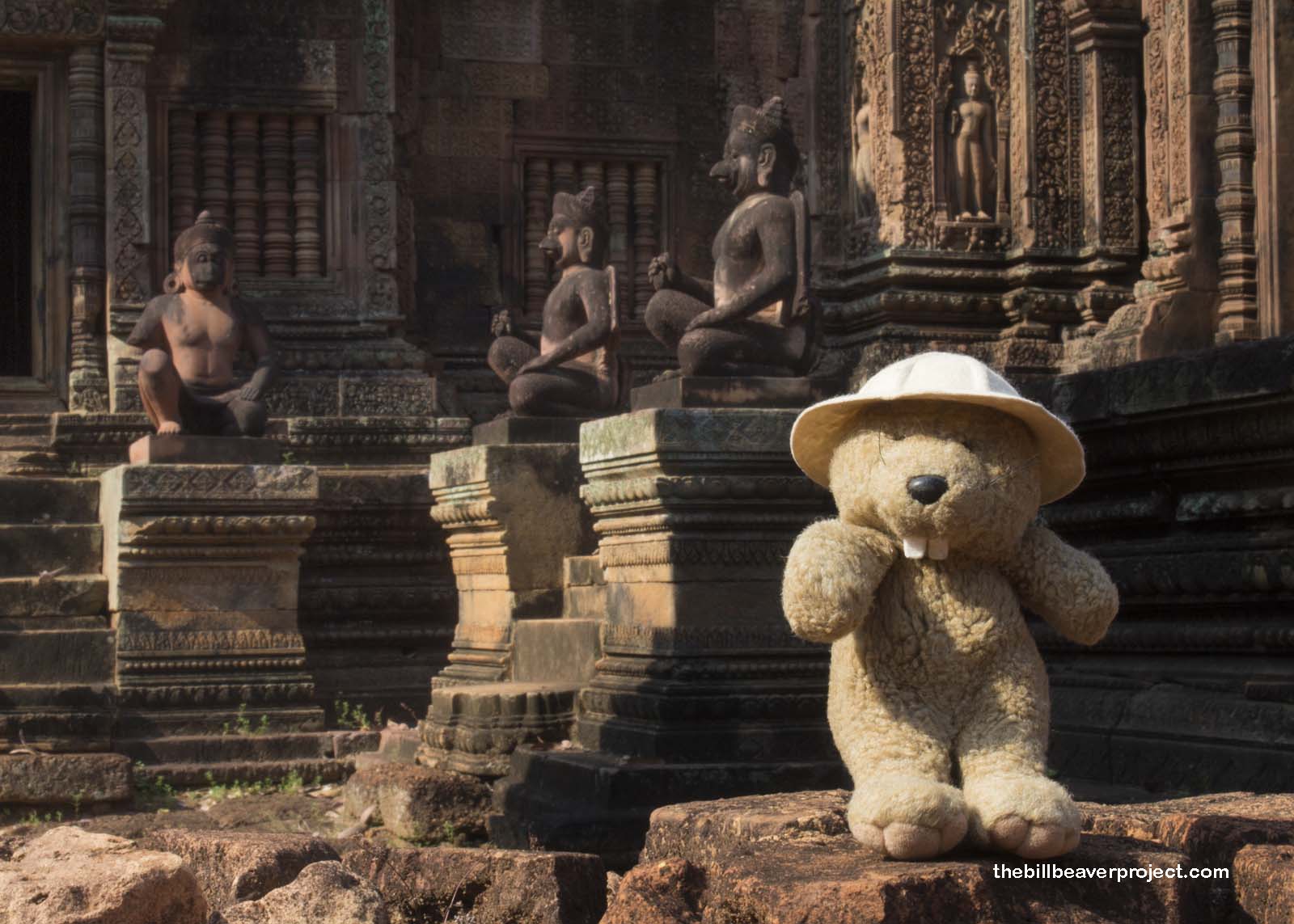 |
We filed out of Banteay Srei as the first bus of Chinese tourists filled in. Dora the driver brought us some cold water bottles and lemongrass-scented washcloths to refresh ourselves, because it was already approaching 90°F and 100% humidity outside! The next stop on our adventure was a site featured on the wall carvings of Bayon, the refuge of the Khmer people as they fled an invasion from Java, and the ultimate birthplace of the Khmer Empire: Phom Kulen National Park!
Cambodia’s approach to national parks sure was different than America’s! For starters, there was no welcome sign, only a military checkpoint and a dirt road that can only be traveled up before noon and down after! It was slow going up the dusty dirt road, past fruit vendors and villages that went about their business as usual in this national park, and it was so strange how absent all signs of advertising were! By the time we pulled up to our first stop, there was no way we could have known we’d reached the River of 1000 Lingas if Nara hadn’t told us!
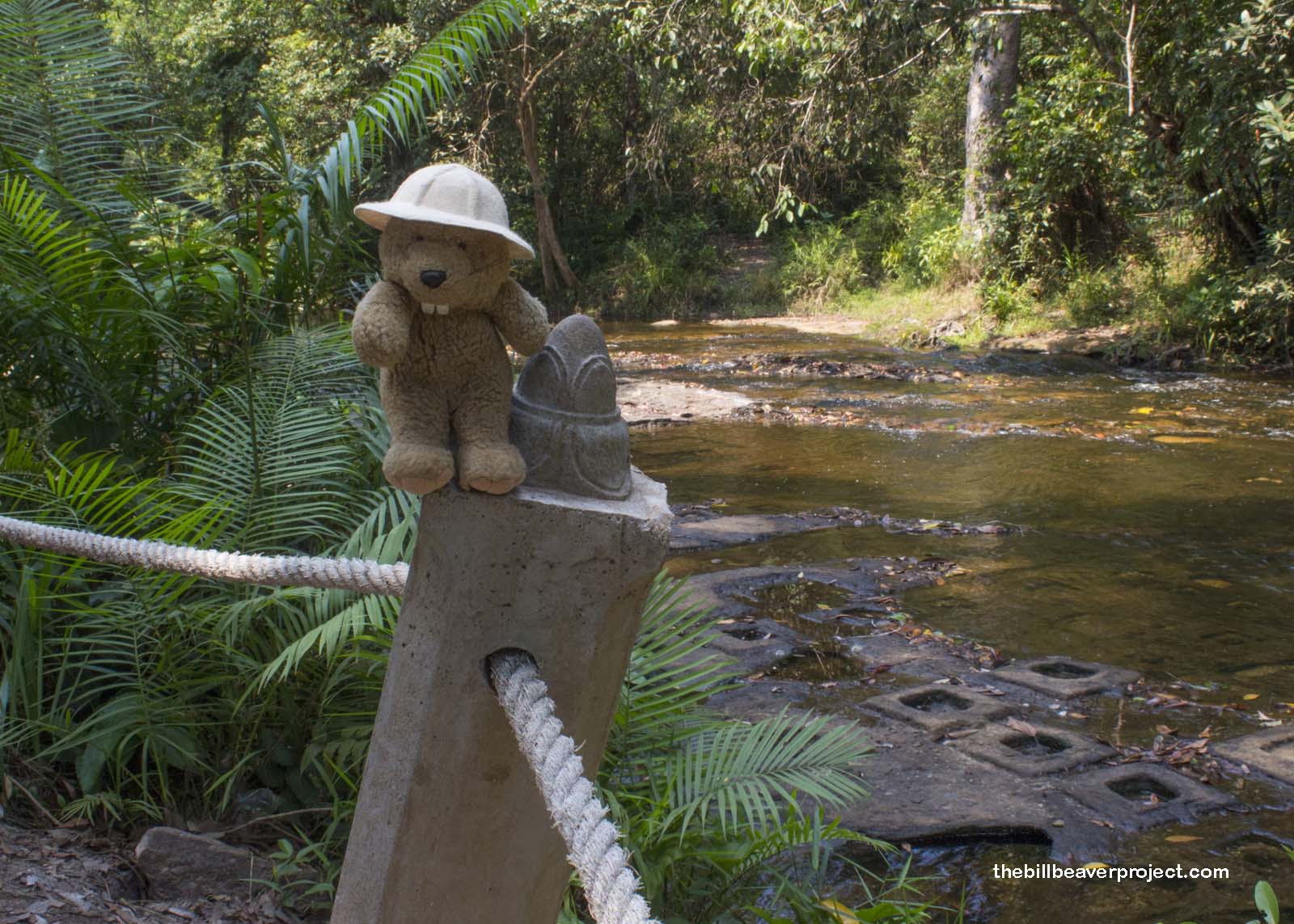 |
In case you were wondering, a linga is a depiction of Shiva’s boy bits, which matches up with the girl bits of Uni, after which all Angkor Temples are designed! So, the River of 1,000 Lingas, as you can piece together, has been carved with the likeness of a thousand divine ding-a-lingas, which are meant to fertilize the Siem Reap River as it flows off Phnom Kulen into the lowlands!
The water here is considered holy, and though swimming is not encouraged—because what god wants his linga stepped on?—there were still a few Indian pilgrims bathing in its water. Nearby, a milky blue pool was also rumored to have miraculous curing powers. Nara said his Hindu mother often asks him to bring her bottles of its water when he gives his tours.
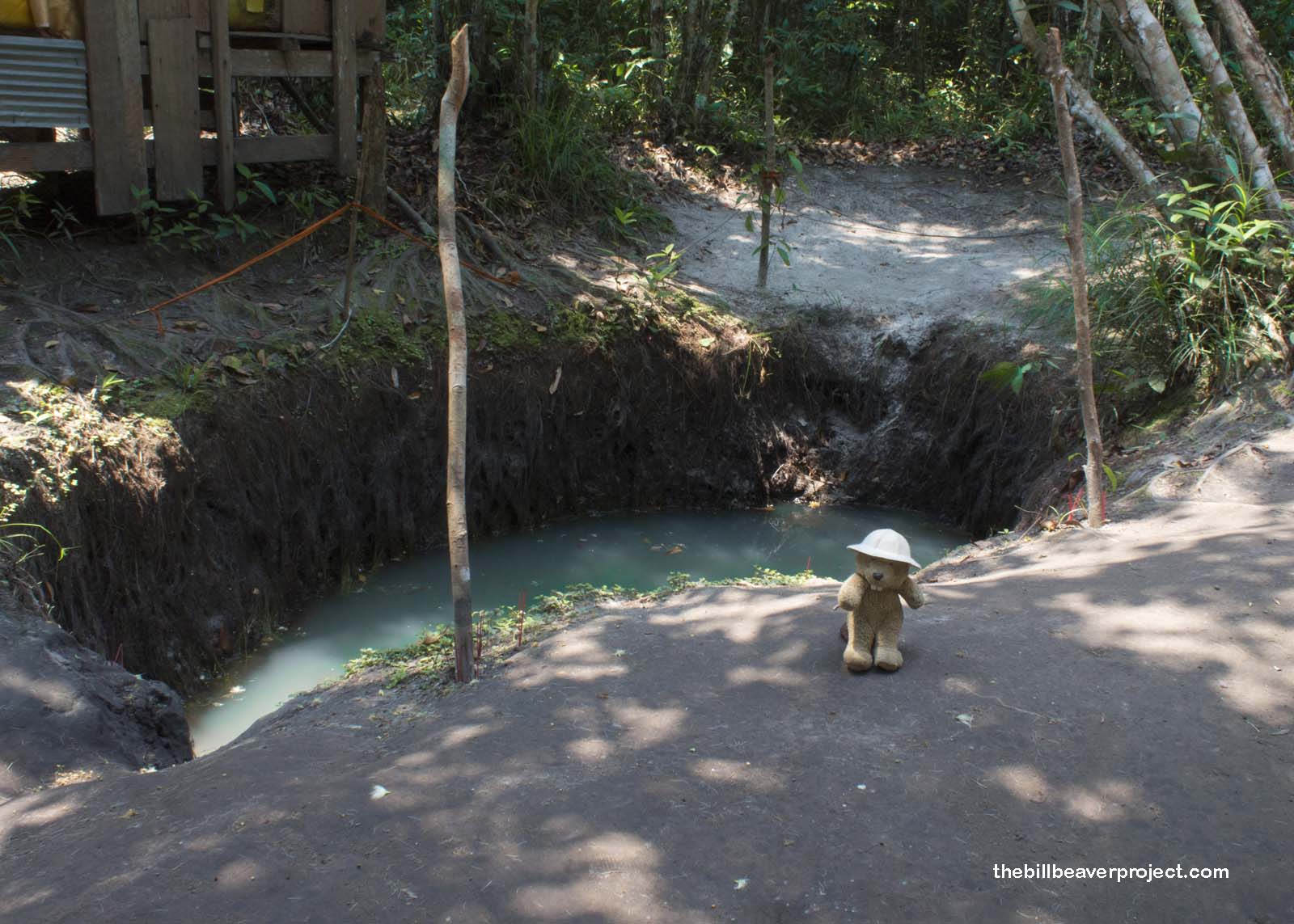 |
From there, we were whisked away to a bustling market, where roasted snakehead fish and the skulls of goats and bears were on sale for use in traditional medicine. We then ascended a long staircase to the meeting place of Cambodia’s three religions: Animism, Hinduism, and Buddhism.
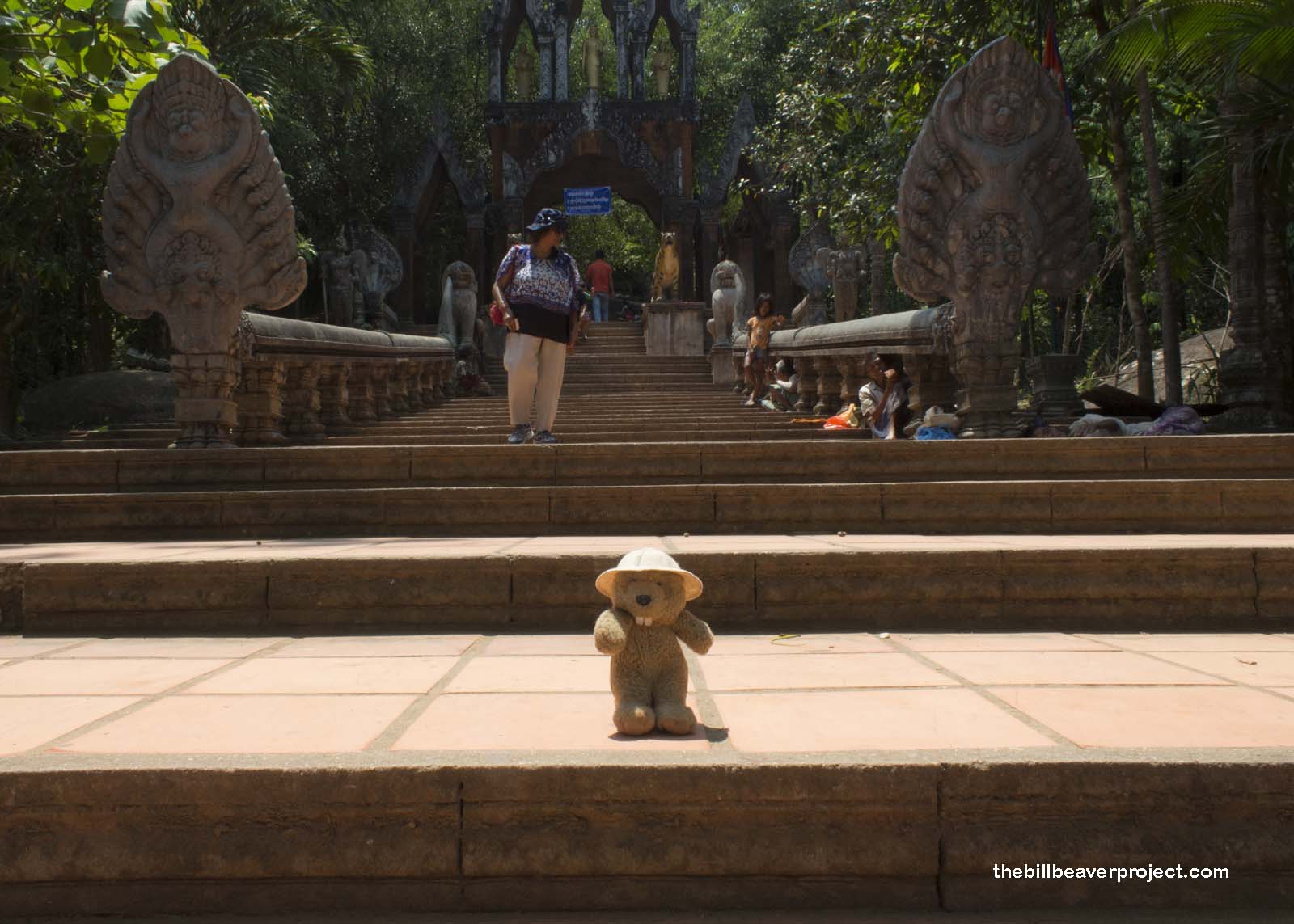 |
This is the holiest site in Cambodia and an amazing crossroads for monks and mystics. Up here, in the shelter of mountain ledges, statues of Vishnu and the Buddha mingled alongside phallic fountains of holy water, with which Nara invited us to wash our faces! A giant imprint in the solid rock is widely revered as the footprint of the original Buddha!
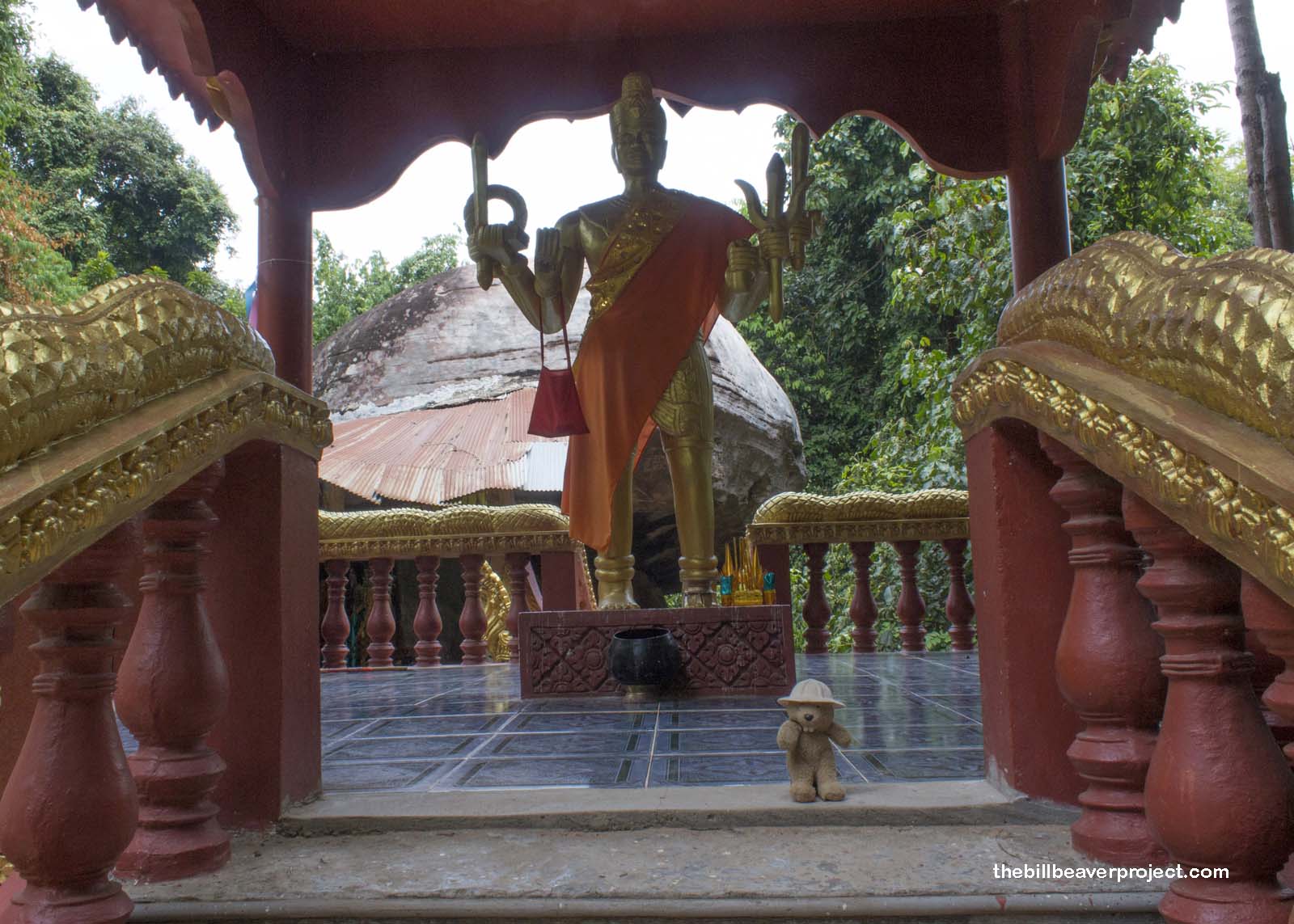 |
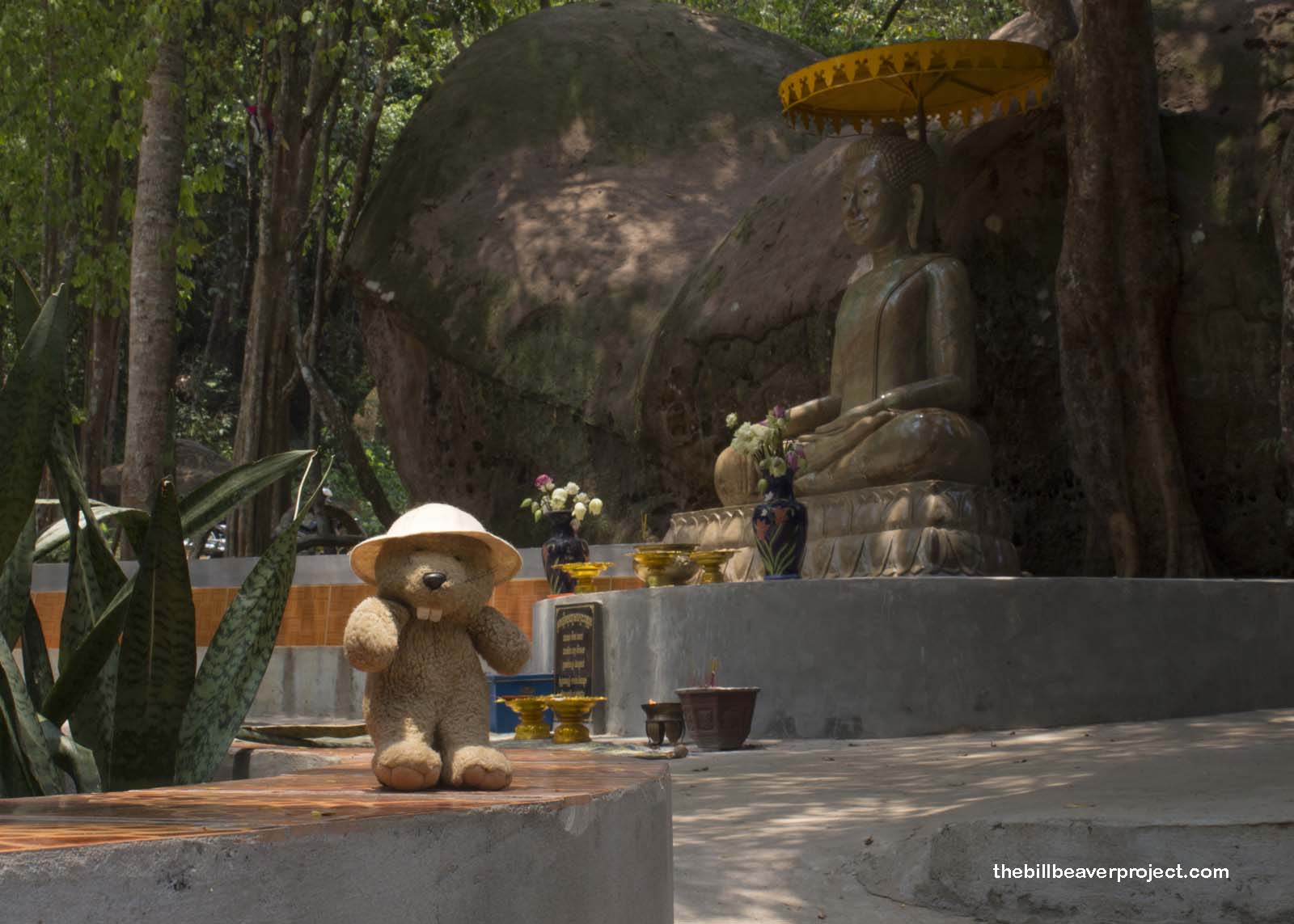 |
Since it’s forbidden to wear your shoes into the presence of the Buddha, before we could see the magnificent Reclining Buddha of Preah Ang Thom, Mu Sab and Nara gave their shoes to a little girl to guard, and we ascended the long flight of stairs to the pagoda!
Built into the rock of the mountain, this Buddha is a collage of traditions! Some visitors (probably Thai) have coated it in small flakes of gold leafing. Others, ignoring the signs, have written messages to the Buddha. Still others, which Nara could not explain, had rouged the lips of some of the lesser bodhisattvas around the border. Whether it was respect or disrespect for the Buddha, it’s hard to say, but everyone has a different approach to this holy site.
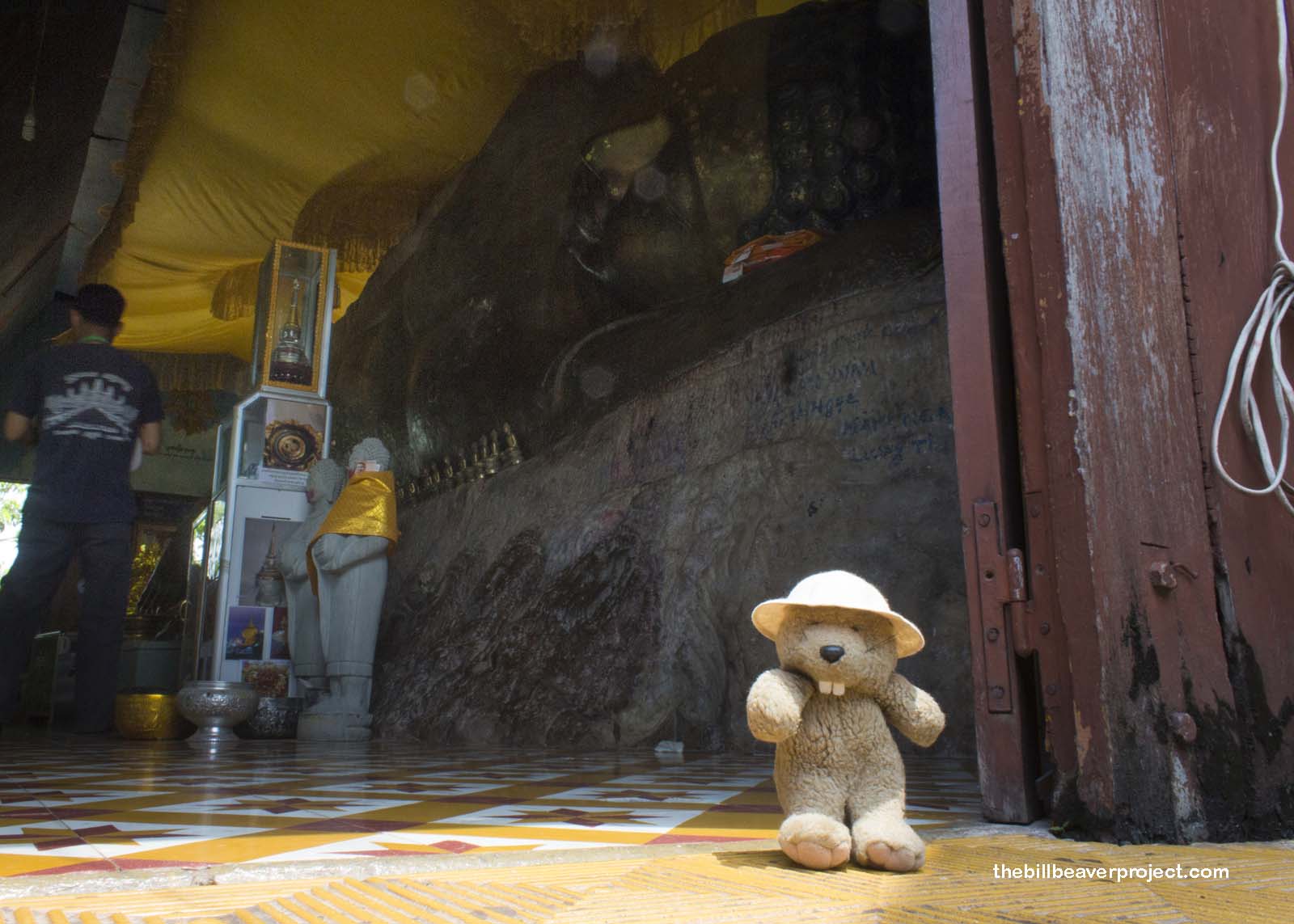 |
In my case, though I made sure to stay outside when taking a photo, I was surprised that this picture alone, out of all the photos I took on this trip, had little glowing orbs scattered around the frame. I hope that’s good karma and not an angry Buddha. I guess we’ll see how the rest of this trip goes!
As we descended the long stairs, flanked by prayer flags, Nara pointed out a grove of lychee trees, just the sort that gave Phnom Kulen (“Lychee Mountain”) its name! We were also able to see, way off in the distance, the approach of some ominous thunderheads. We were going to have to quicken our pace!
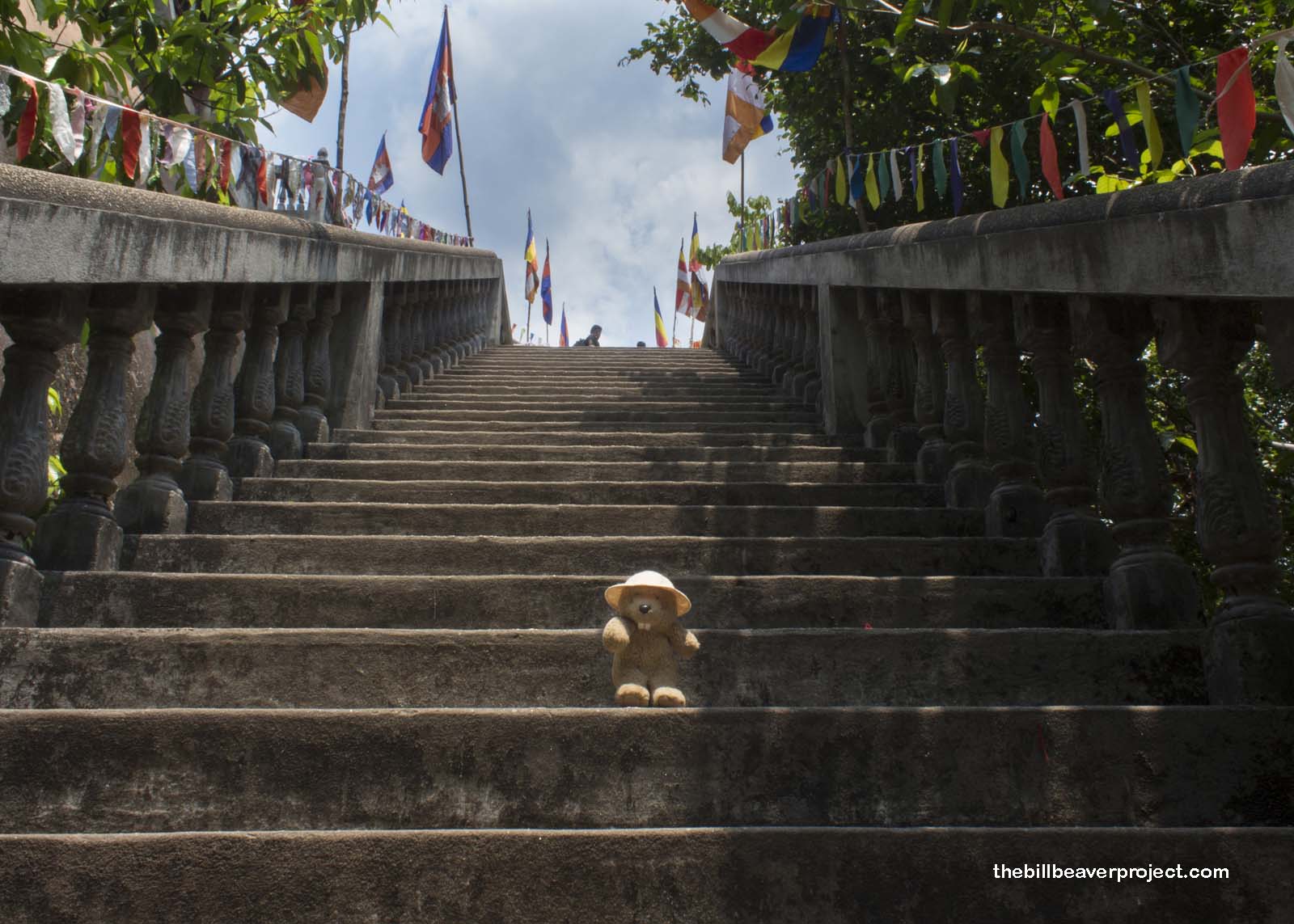 |
Once my companions got their shoes back from the little girl for a dollar, Nara led us on a trail into the jungle, past the secluded shrines of monks and hermits. The trail was built upon layers and layers of garbage, which was really disheartening to see, given the holiness of the place, but it seems the government has not yet invested money into garbage cans or sanitation workers in this national park!
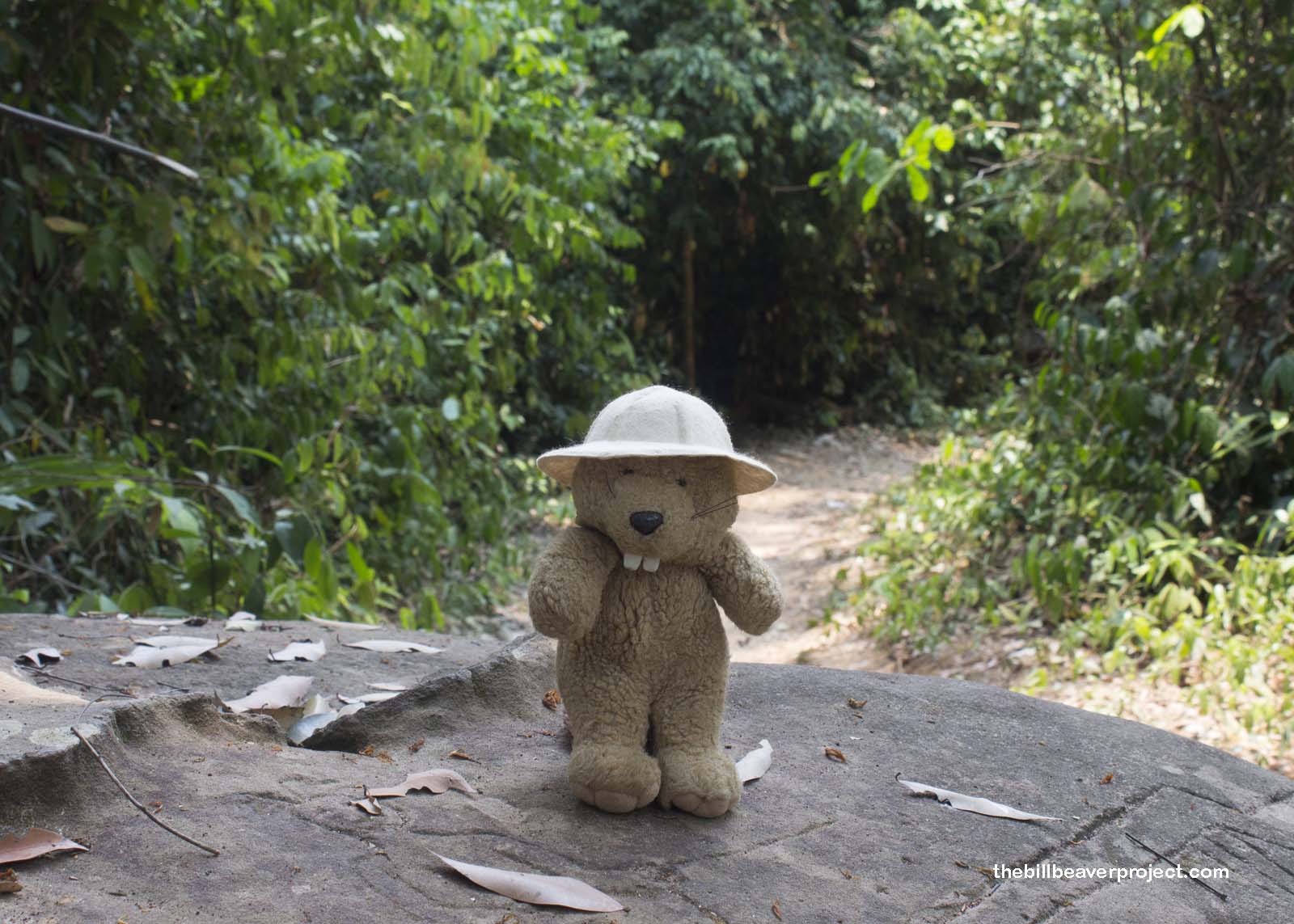 |
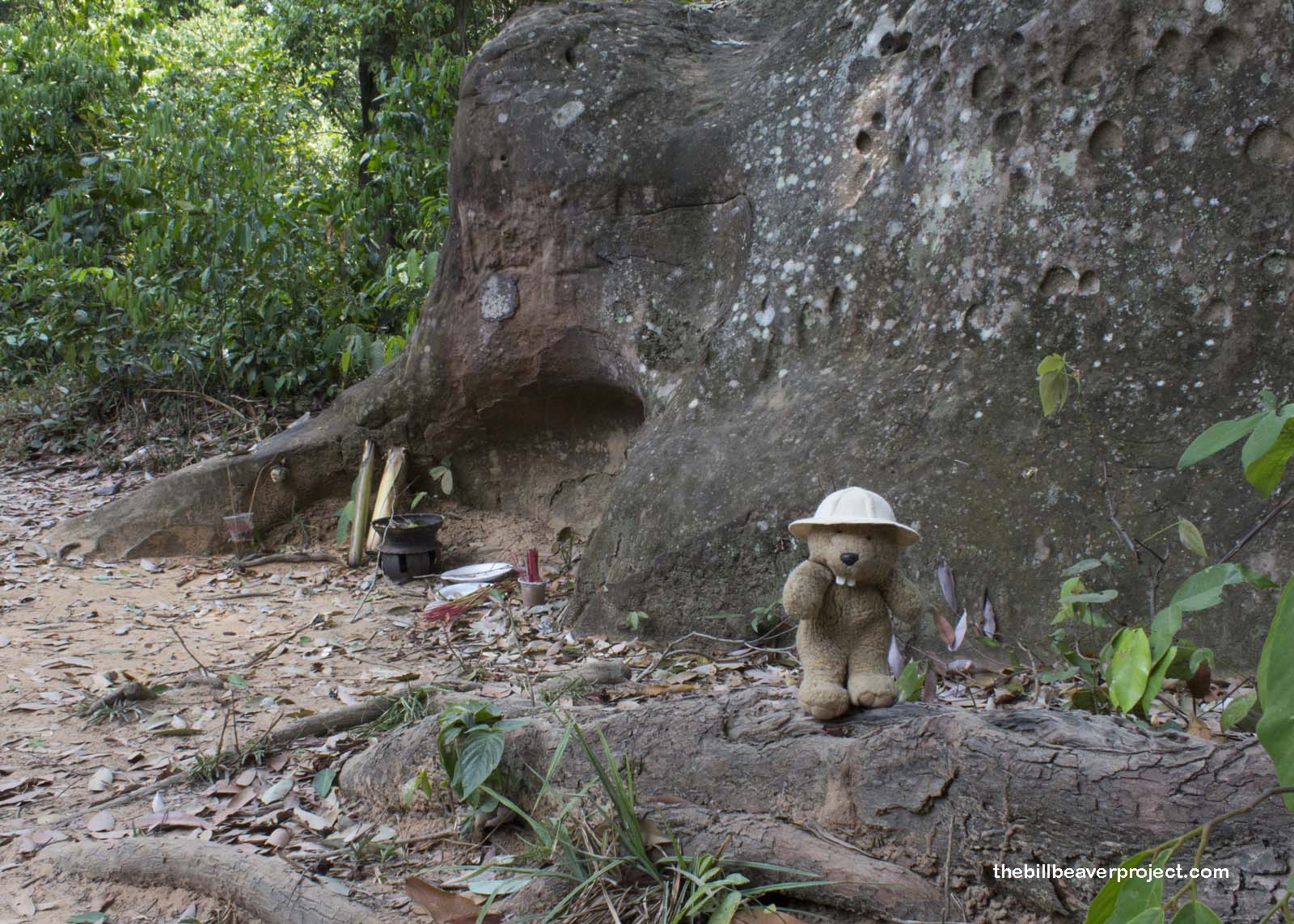 |
At last, we reached what appeared to be the summit of Phnom Kulen. We stopped while Nara explained that this is where Jayavarman II declared himself deva-raja (“god-king”) of the Khmer Empire in roughly 802 AD! Though he borrowed the idea of deva-raja from Hinduism, he set up a casteless system of mutual respect among Cambodia’s religions that Phnom Kulen still embodies today! The Khmer Empire ruled most of what is now Cambodia, Thailand, Laos, and southern Vietnam until 1431 AD when the Thai Kingdom of Ayutthaya arose and broke it apart!
A group of Buddhist monks had been watching us the whole time Nara told his story. Midway through, one of them snapped a photo of us with his iPhone! That was unexpected!
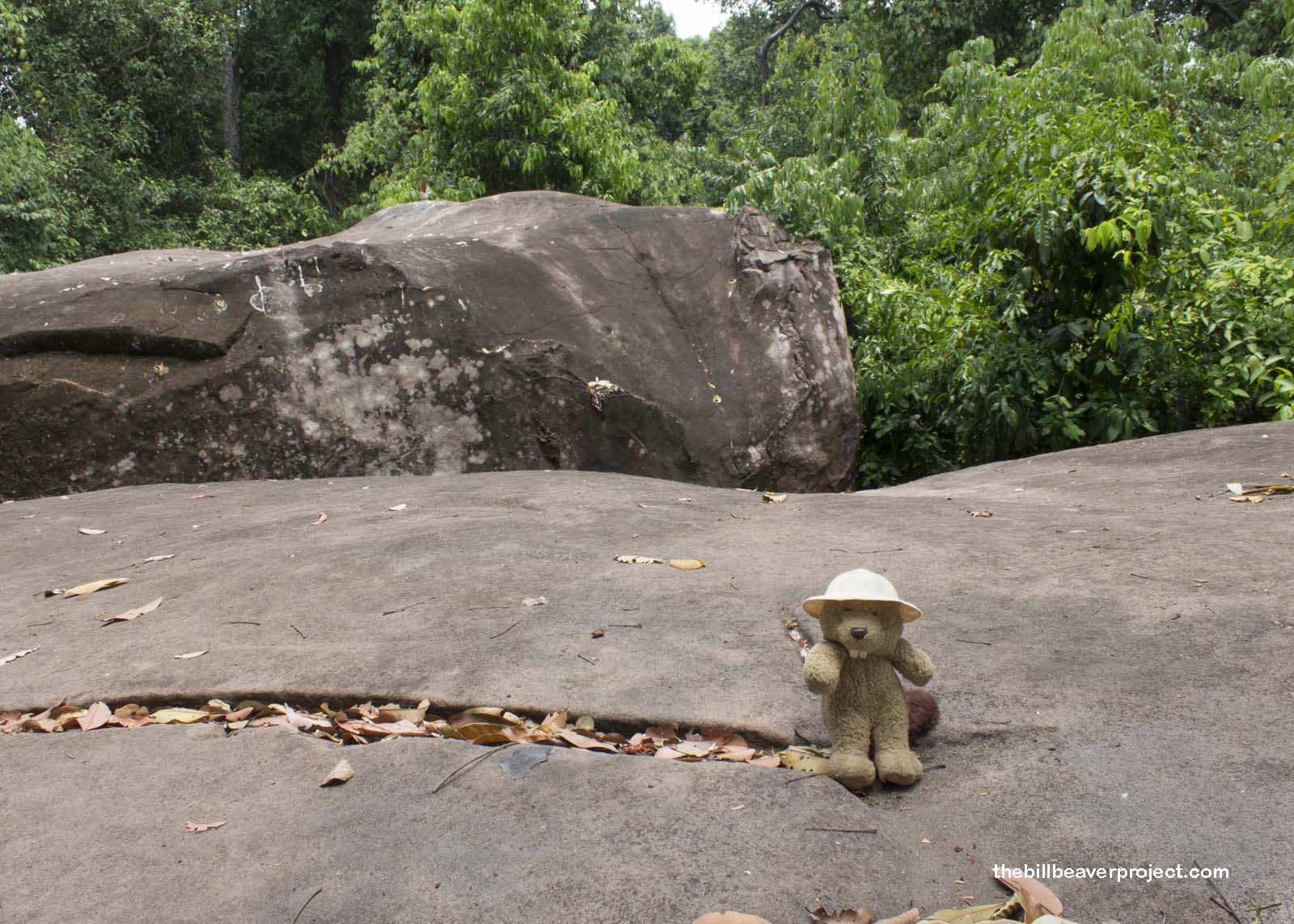 |
Nara pointed out a small pool carved into the rock, where he said the legendary Leper King (possibly Jayavarman himself) had come to seek healing from a Hermit who lived here. The Hermit created a pool of boiling water and instructed the king to jump in. The king refused to do because it was boiling! So the Hermit took a mangy dog and tossed it in. The dog hopped out, cured of its mange! But the Hermit refused to heal the Leper King, who would go on to retain his legendary title.
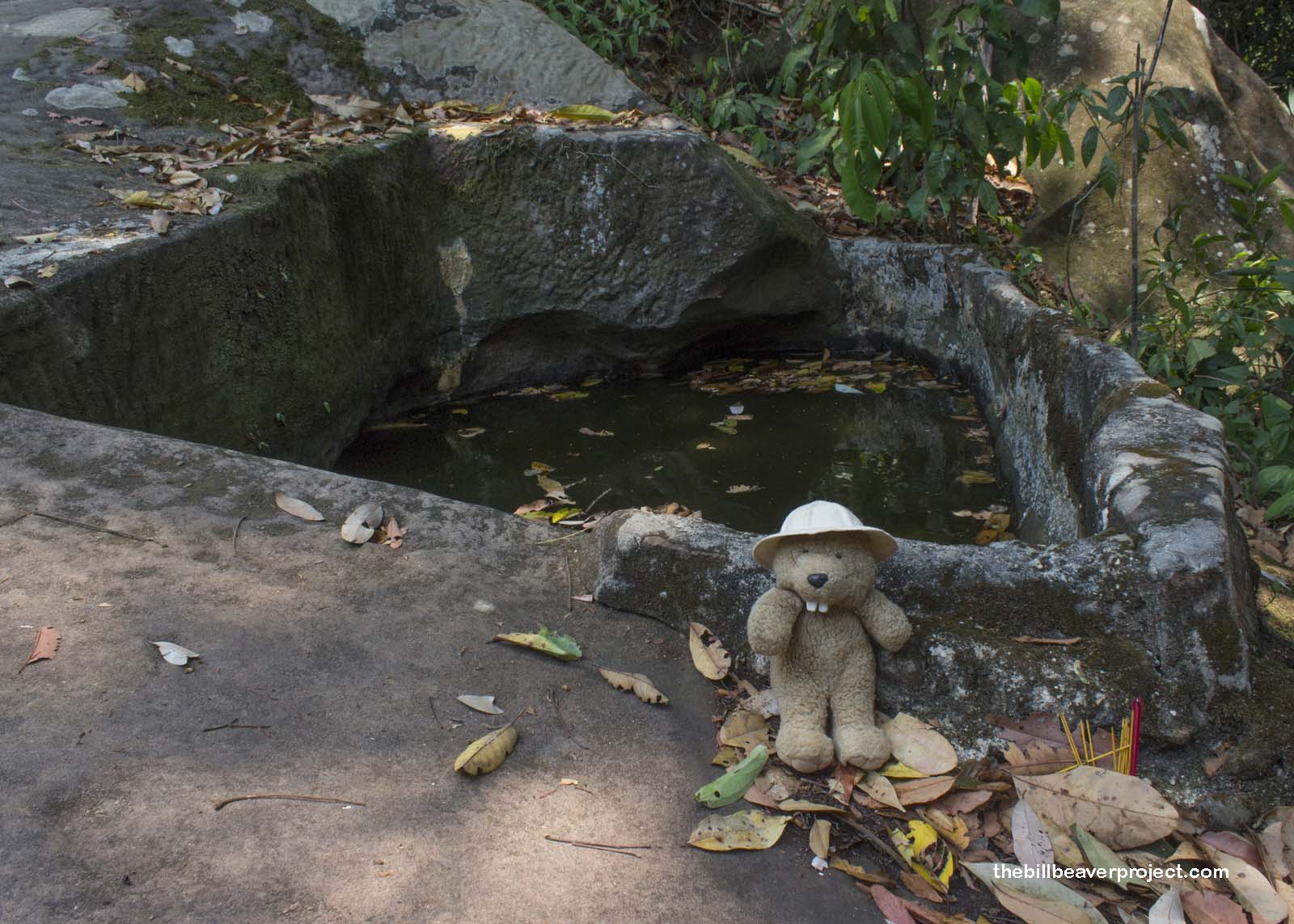 |
As the storm clouds grew darker overhead, we made our last stop in this national park: Kulen Waterfall. A huge draw for locals on weekends and especially during the Cambodian New Year, there were tons of people running through the upper fall, and plenty more at the lower fall where we enjoyed the greenery and the swings! A few monks had turned their robes into impromptu swimsuits and were taking time to frolic in the water. I was about to take a dip too, when the sky beat me to it! We raced back to the car as a cascade of water poured down upon us!
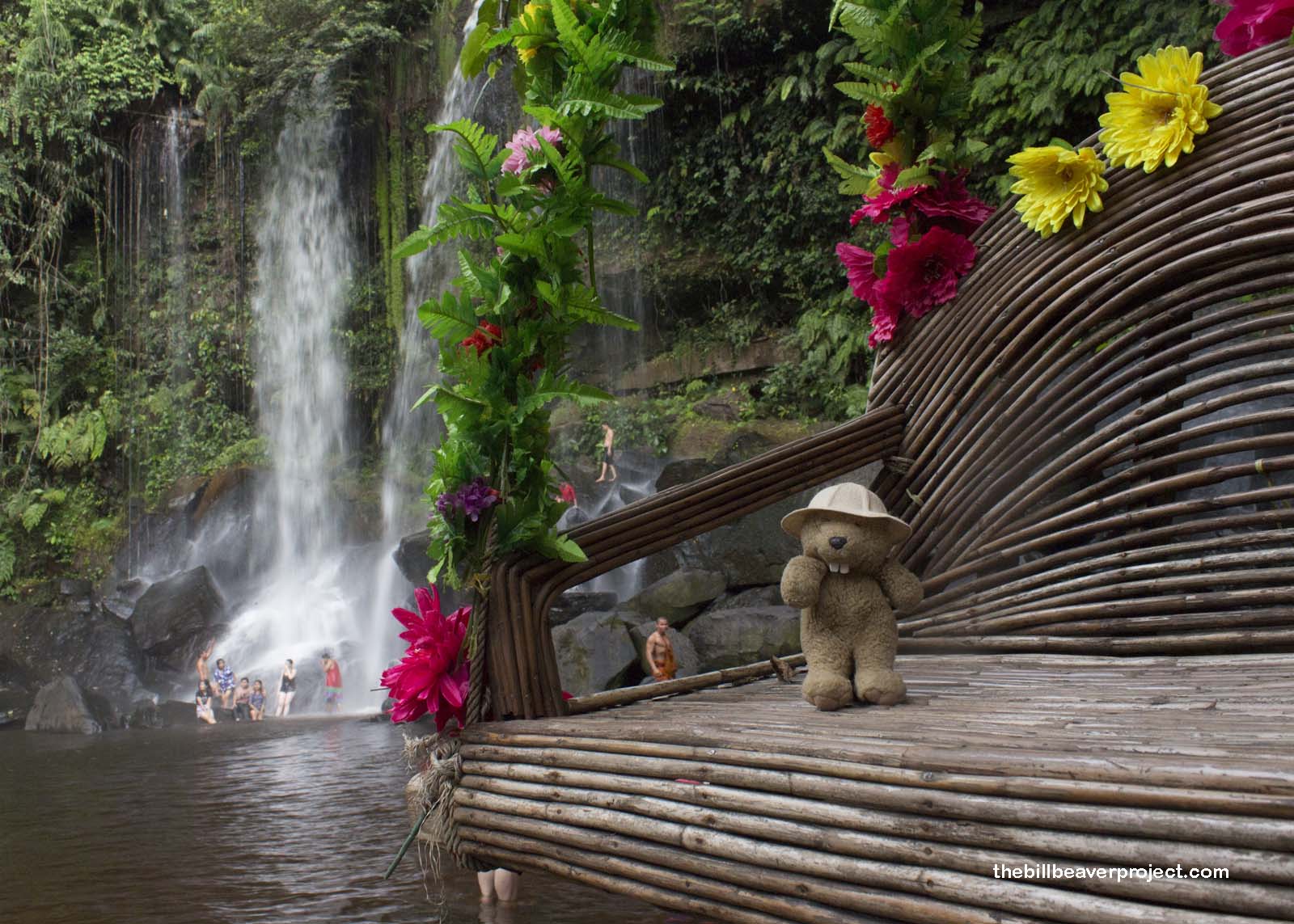 |
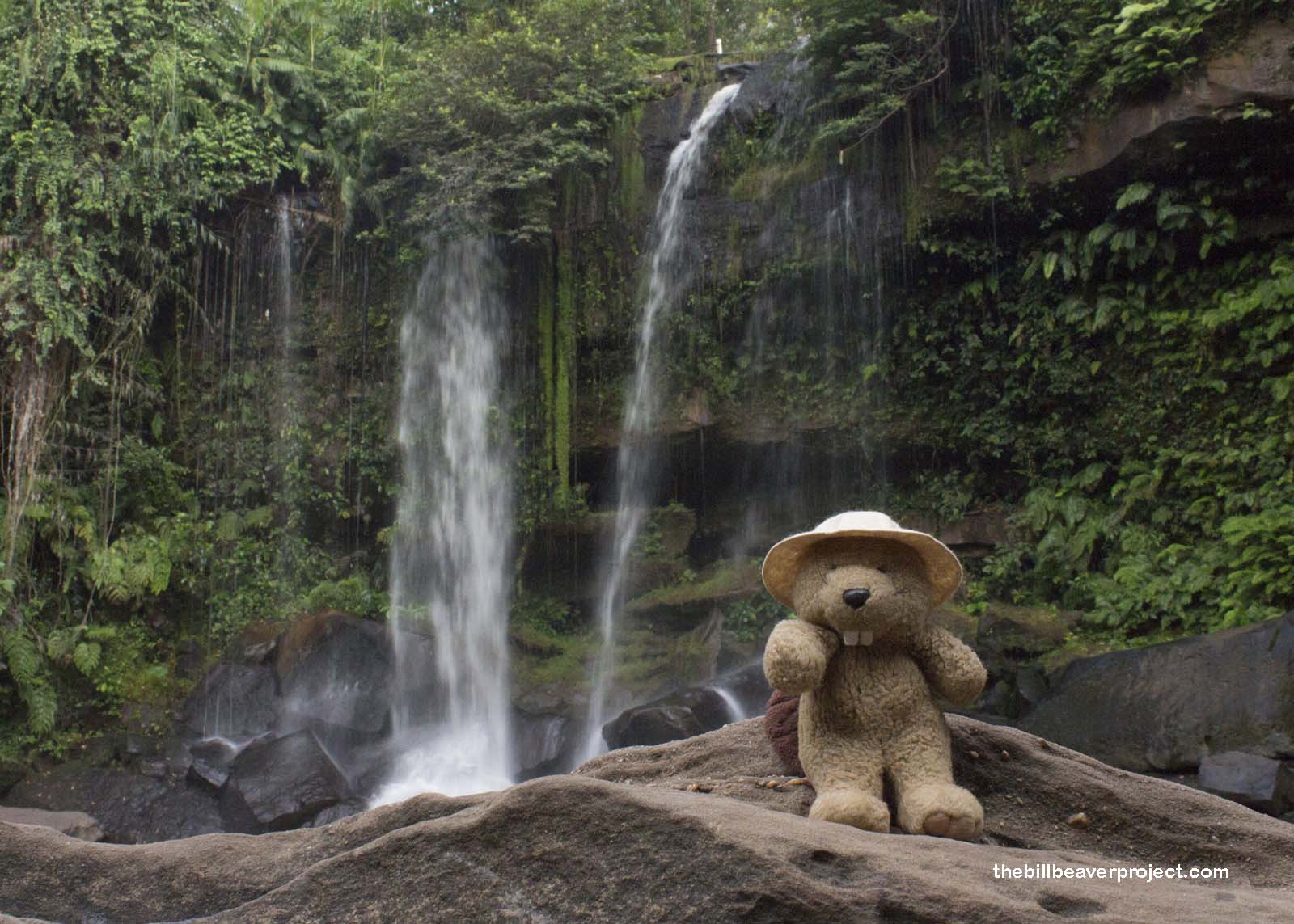 |
Drenched, we slogged our way down the muddy road off the mountain, munching on fried bananas that Nara had picked up from one of the vendors, and headed further east to our final destination: Beng Mealea!
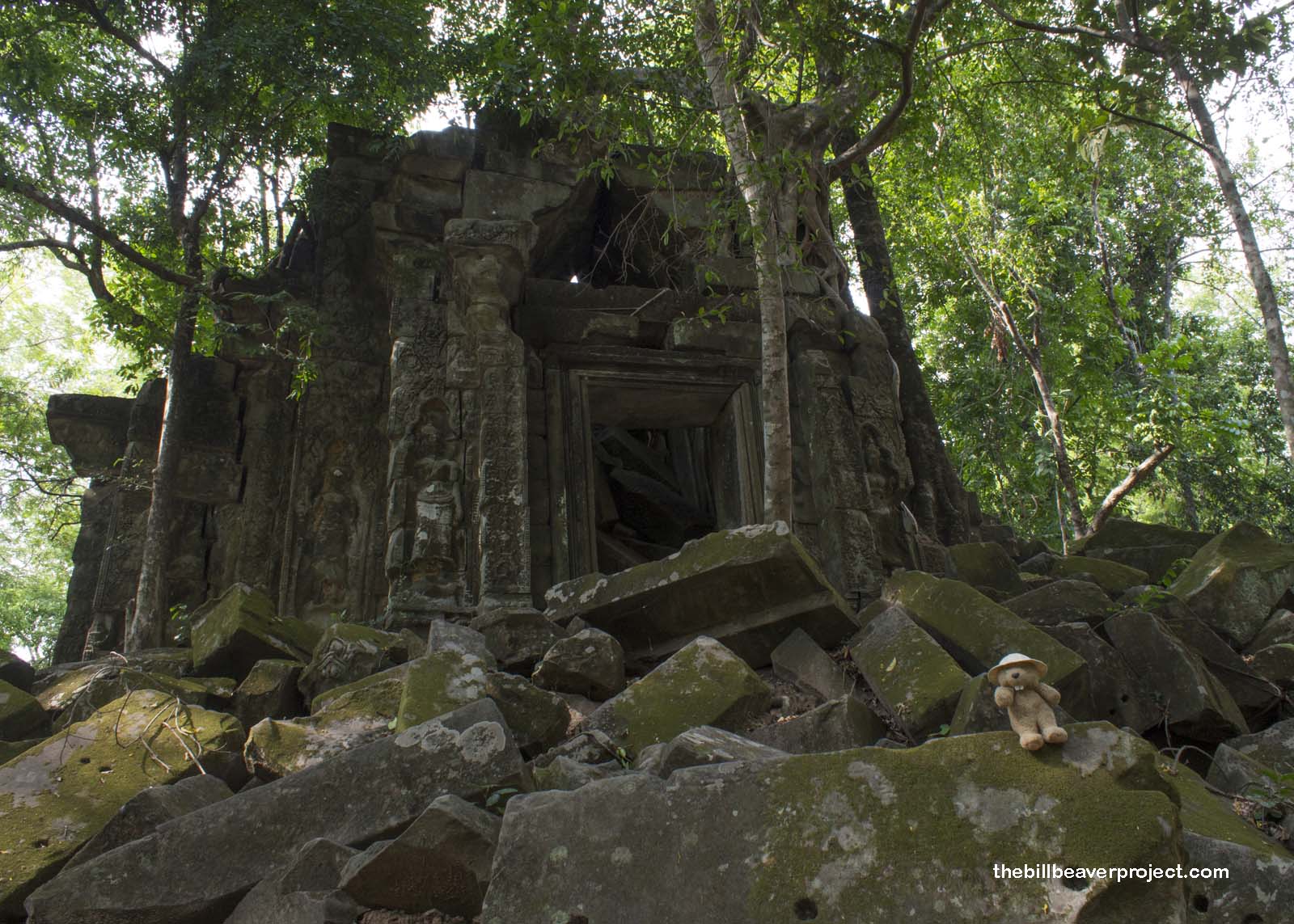 |
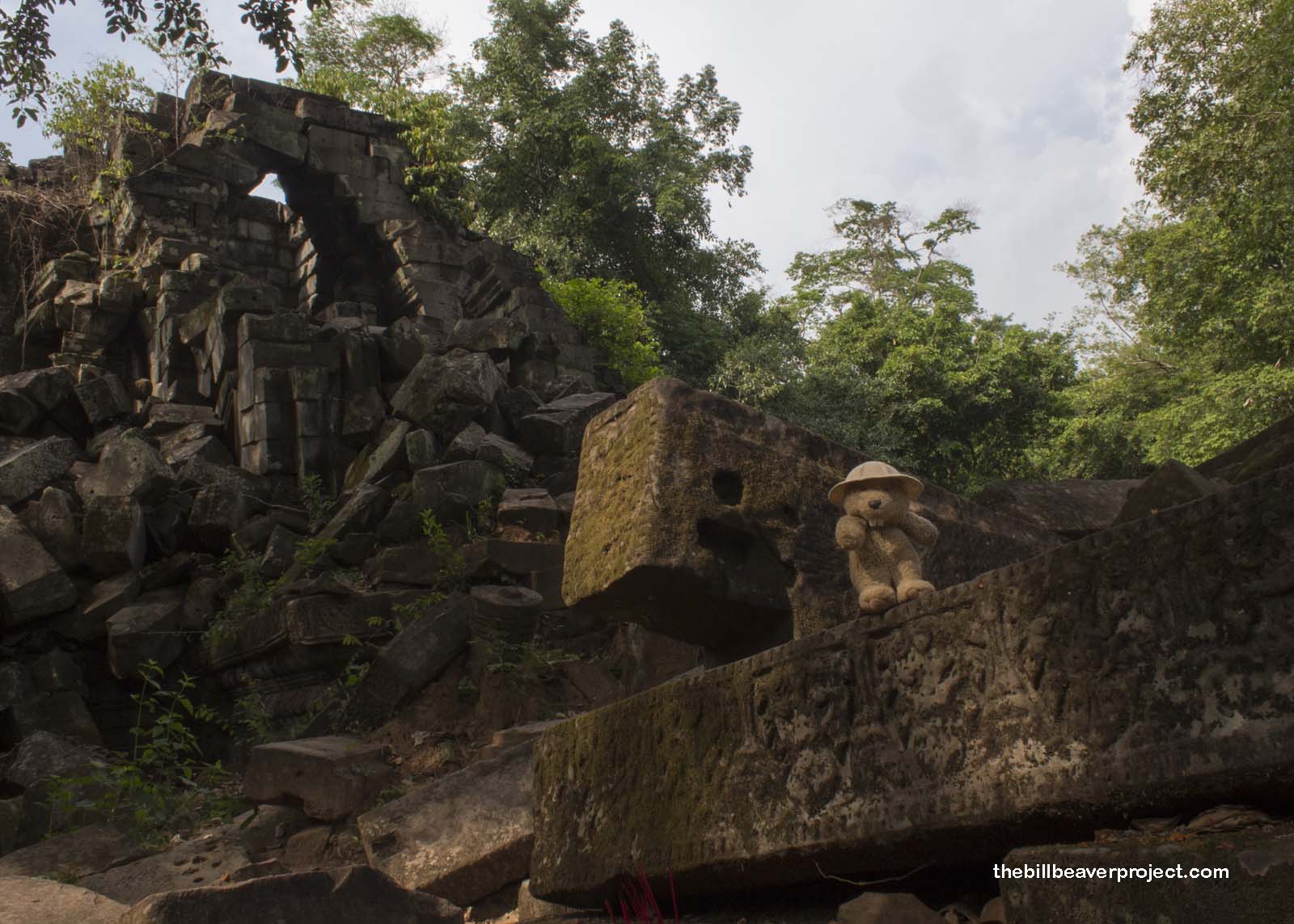 |
Beng Mealea is the opposite of Banteay Srei: a gray temple overrun by the jungle! With only a few carvings still around and no names or dates anywhere to be found, it’s only a matter of guesswork that this temple was built around the same time as Angkor Wat and maybe by the same king!
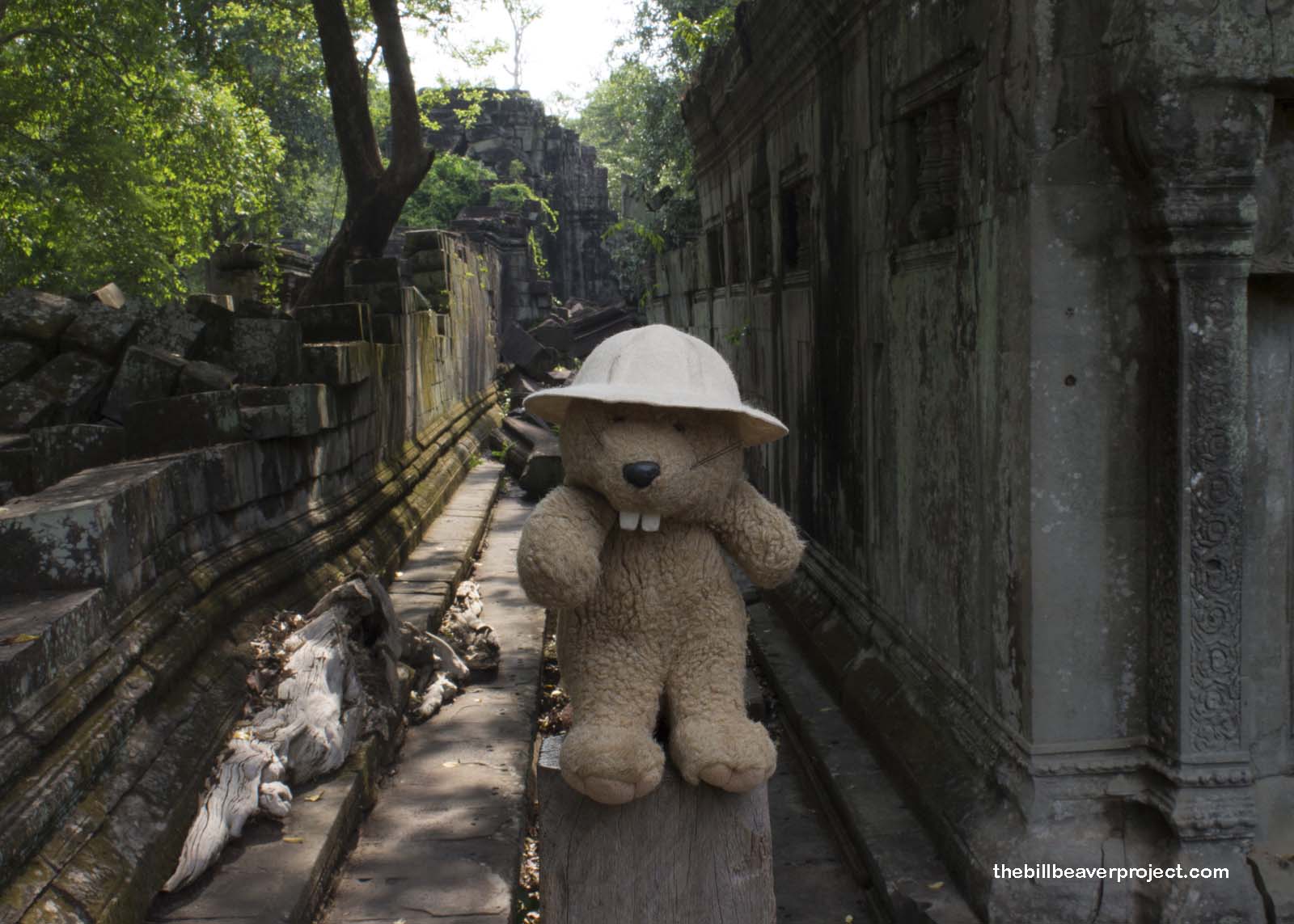 |
It was fitting that this temple should be so shrouded in mystery! Away from the main hub of tourists, where locals fished by hand in the lotus ponds that gave Beng Mealea its name, this was a cool refuge of nature reclaiming the structures of humanity! Where once folks would clamber over the stone walls, there are now boardwalks to keep visitors as observers, rather than actors, in the natural process!
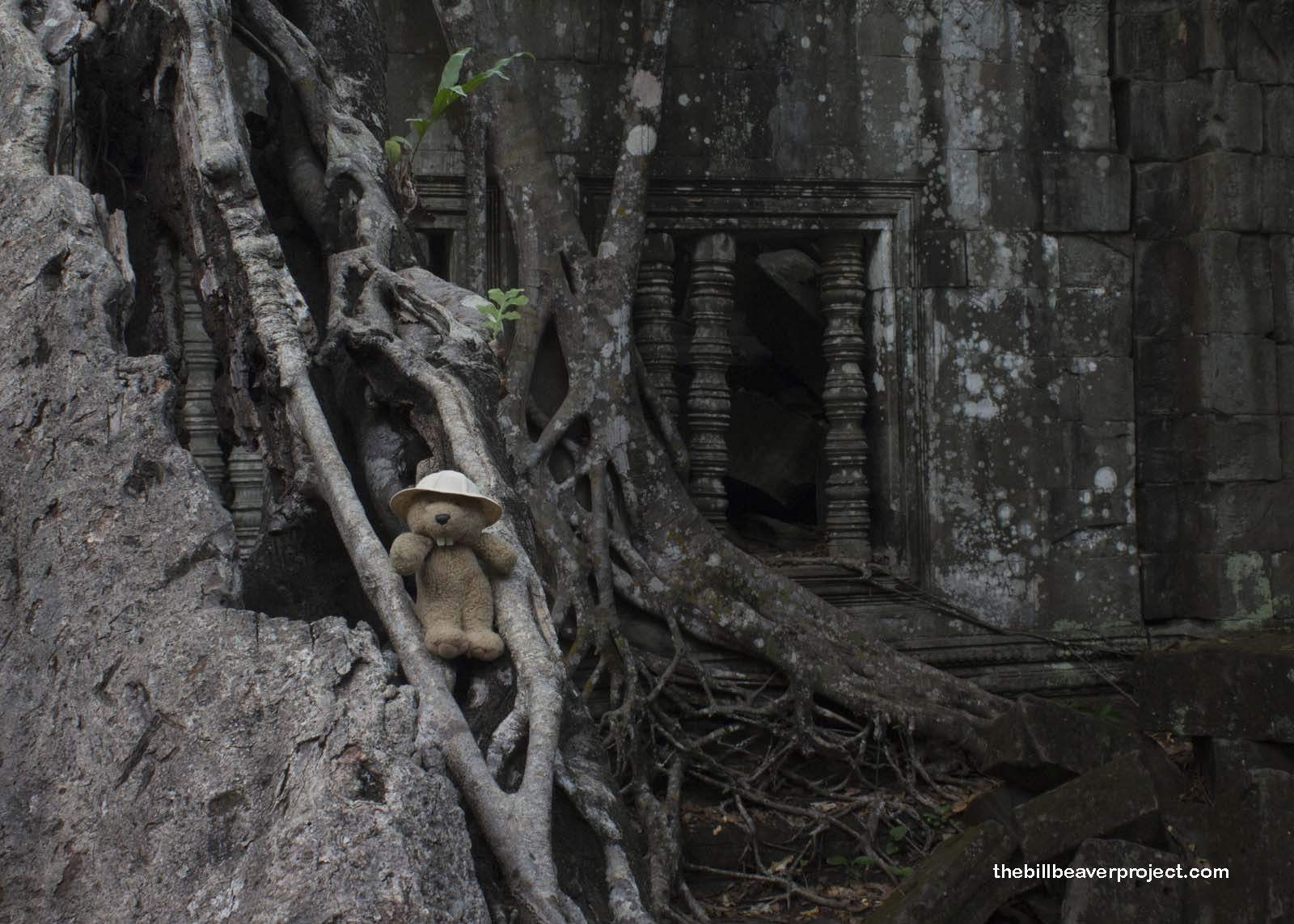 |
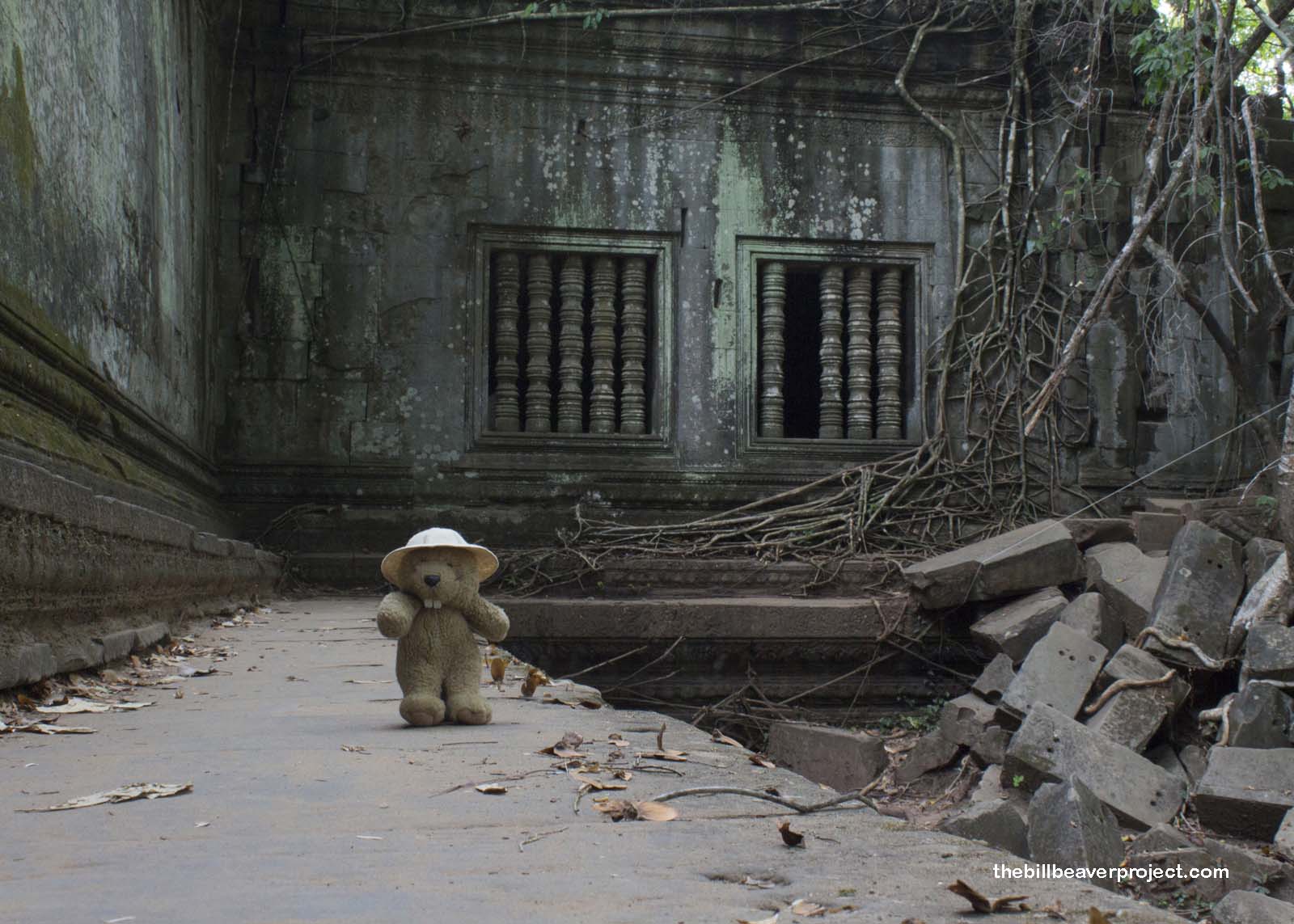 |
We finished up our long day by wandering a rice paddy and watching egrets at sunset. I was surprised to find little freshwater crabs running around, but I guess that’s what draws the egrets! As the sun set, we said “So long” to Nara and Dora and thanked them for all the great information they provided. It was really neat getting such an intimate glimpse into the history and culture of Cambodia. Now, after all that, it was time for a big dinner at the hotel and a complimentary massage. We’ve got another early morning tomorrow, so…
Réatri suŏ sdei!

 Previous Day |
Total Ground Covered: 147.3 mi (237.0 km) |
 Next Day |
